Passenger Travel Path Selection Based on the Characteristic Value of Transport Services
Abstract
:1. Introduction
2. Methods
2.1. Path Scenario Setting
2.2. Generalized Cost Function
2.2.1. Ticket Price (E)
2.2.2. Quickness (Q)
2.2.3. Convenience (F)
2.2.4. Comfort (C)
2.2.5. Security (S)
2.3. Travel Path Selection Probability Model
2.4. Ridge Regression Model
3. Case Analysis
3.1. Travel Route Screening
3.2. Analysis of Passenger Travel Preference
3.3. Regression Analysis
3.3.1. Multicollinearity Test
3.3.2. Ridge Regression Estimation
3.3.3. Results Analysis of Ridge Regression
3.3.4. Influence of Fatigue Recovery Time on the Travel Choice of Passengers
3.3.5. Influence of Travel Time on the Travel Choice of Passengers
3.3.6. The Influence of Per Capita Time Value on the Travel Choice of Passengers
4. Conclusions
- In the travel network of the Chengdu–Chongqing economic circle, 47.8% of the total number of passengers chose high-speed rail for direct travel. Under the air–rail combination travel scenario, Chengdu and Yibin have relatively obvious hub characteristics.
- The conducted ridge regression analysis found that comfort had the greatest impact on the probability of passengers choosing air direct. Convenience had the greatest impact on the probability of choosing high-speed rail direct, which was slightly higher than the probability of choosing air direct. Passengers were least inclined toward choose HA travel when the ticket’s price increased, while the impact on the probability of choosing air direct was relatively small.
- By means of sensitivity analyses, it was found that the factors that constitute the generalized cost have certain differences in the impact of passengers’ choice behavior. Fatigue recovery times were not sufficiently flexible for passengers to choose their travel mode, while the travel time and per capita time value of the main traffic are flexible for passengers to choose their travel modes. At the same time, the sensitivity of the three factors relative to a passenger’s travel choice ranked from high-speed rail direct, air–rail combined travel, and air direct.
Author Contributions
Funding
Institutional Review Board Statement
Informed Consent Statement
Data Availability Statement
Conflicts of Interest
References
- Gi, K.; Sano, F.; Akimoto, K. Bottom-up Development of Passenger Travel Demand Scenarios in Japan Considering Heterogeneous Actors and Reflecting a Narrative of Future Socioeconomic Change. Futures 2020, 120, 102553. [Google Scholar] [CrossRef]
- Chai, J.; Zhou, Y.; Zhou, X.; Wang, S.; Zhang, Z.G.; Liu, Z. Analysis on Shock Effect of China’s High-Speed Railway on Aviation Transport. Transp. Res. Pt. A-Policy Pract. 2018, 108, 35–44. [Google Scholar] [CrossRef]
- Li, Z.-C.; Sheng, D. Forecasting Passenger Travel Demand for Air and High-Speed Rail Integration Service: A Case Study of Beijing-Guangzhou Corridor, China. Transp. Res. Pt. A-Policy Pract. 2016, 94, 397–410. [Google Scholar] [CrossRef]
- Wang, Y.; Sun, L.; Teunter, R.H.; Wu, J.; Hua, G. Effects of Introducing Low-Cost High-Speed Rail on Air-Rail Competition: Modelling and Numerical Analysis for Paris-Marseille. Transp. Policy 2020, 99, 145–162. [Google Scholar] [CrossRef]
- Sun, X.; Zhang, Y.; Wandelt, S. Air Transport versus High-Speed Rail: An Overview and Research Agenda. J. Adv. Transp. 2017, 2017, e8426926. [Google Scholar] [CrossRef] [Green Version]
- Pagliara, F.; Vassallo, J.M.; Román, C. High-Speed Rail versus Air Transportation: Case Study of Madrid–Barcelona, Spain. Transp. Res. Record 2012, 2289, 10–17. [Google Scholar] [CrossRef] [Green Version]
- Yamín, D.; Medaglia, A.L.; Prakash, A.A. Exact Bidirectional Algorithm for the Least Expected Travel-Time Path Problem on Stochastic and Time-Dependent Networks. Comput. Oper. Res. 2022, 141, 105671. [Google Scholar] [CrossRef]
- Hu, J.; Yang, B.; Guo, C.; Jensen, C.S. Risk-Aware Path Selection with Time-Varying, Uncertain Travel Costs: A Time Series Approach. VLDB J. 2018, 27, 179–200. [Google Scholar] [CrossRef]
- Feng, Y.; Zhao, J.; Sun, H.; Wu, J.; Gao, Z. Choices of Intercity Multimodal Passenger Travel Modes. Physica A 2022, 600, 127500. [Google Scholar] [CrossRef]
- Wang, Y.; Yan, X.; Zhou, Y.; Xue, Q. Influencing Mechanism of Potential Factors on Passengers’ Long-Distance Travel Mode Choices Based on Structural Equation Modeling. Sustainability 2017, 9, 1943. [Google Scholar] [CrossRef]
- Wang, J.; Jiao, J.; Du, C.; Hu, H. Competition of Spatial Service Hinterlands between High-Speed Rail and Air Transport in China: Present and Future Trends. J. Geogr. Sci. 2015, 25, 1137–1152. [Google Scholar] [CrossRef]
- Cadarso, L.; Vaze, V.; Barnhart, C.; Marín, Á. Integrated Airline Scheduling: Considering Competition Effects and the Entry of the High Speed Rail. Transp. Sci. 2017, 51, 132–154. [Google Scholar] [CrossRef]
- Su, M.; Luan, W.; Yuan, L.; Zhang, R.; Zhang, Z. Sustainability Development of High-Speed Rail and Airline—Understanding Passengers’ Preferences: A Case Study of the Beijing–Shanghai Corridor. Sustainability 2019, 11, 1352. [Google Scholar] [CrossRef] [Green Version]
- Li, Y.-T.; Schmöcker, J.-D. Adaptation Patterns to High Speed Rail Usage in Taiwan and China. Transportation 2017, 44, 807–830. [Google Scholar] [CrossRef]
- Li, X.; Li, X.; Li, X.; Qiu, H. Multi-Agent Fare Optimization Model of Two Modes Problem and Its Analysis Based on Edge of Chaos. Physica A 2017, 469, 405–419. [Google Scholar] [CrossRef]
- Ruiz-Rúa, A.; Palacín, R. Towards a Liberalised European High Speed Railway Sector: Analysis and Modelling of Competition Using Game Theory. Eur. Transp. Res. Rev. 2013, 5, 53–63. [Google Scholar] [CrossRef] [Green Version]
- Zhang, A.; Wan, Y.; Yang, H. Impacts of High-Speed Rail on Airlines, Airports and Regional Economies: A Survey of Recent Research. Transp. Policy 2019, 81, A1–A19. [Google Scholar] [CrossRef]
- Pan, C.; Wang, H.; Guo, H.; Pan, H. How Do the Population Structure Changes of China Affect Carbon Emissions? An Empirical Study Based on Ridge Regression Analysis. Sustainability 2021, 13, 3319. [Google Scholar] [CrossRef]
- İmre, Ş.; Çelebi, D. Measuring Comfort in Public Transport: A Case Study for İstanbul. Transp. Res. Procedia 2017, 25, 2441–2449. [Google Scholar] [CrossRef]
- Du, M.; Chen, A. Sensitivity Analysis for Transit Equilibrium Assignment and Applications to Uncertainty Analysis. Transp. Res. Pt. B-Methodol. 2022, 157, 175–202. [Google Scholar] [CrossRef]
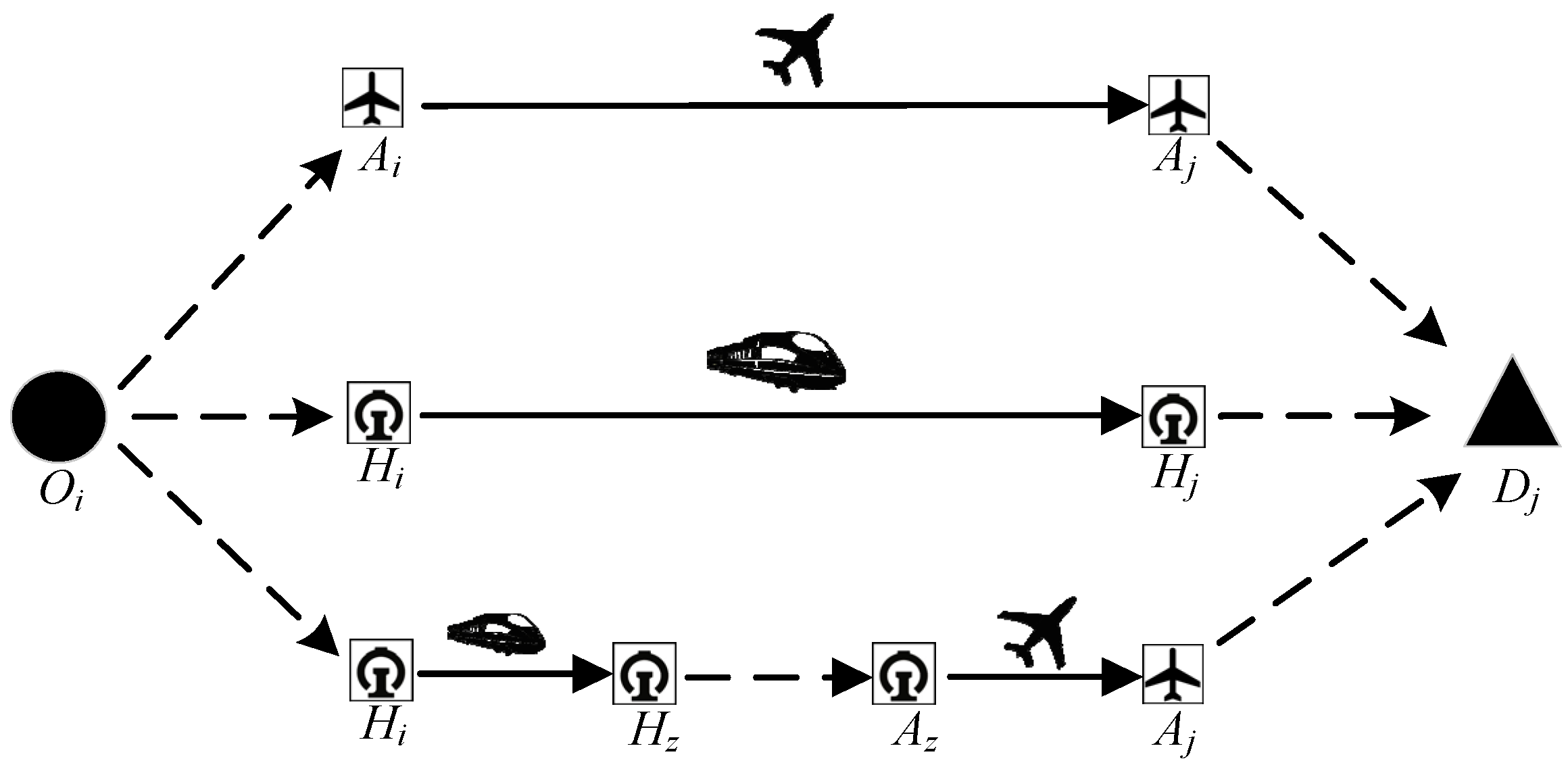
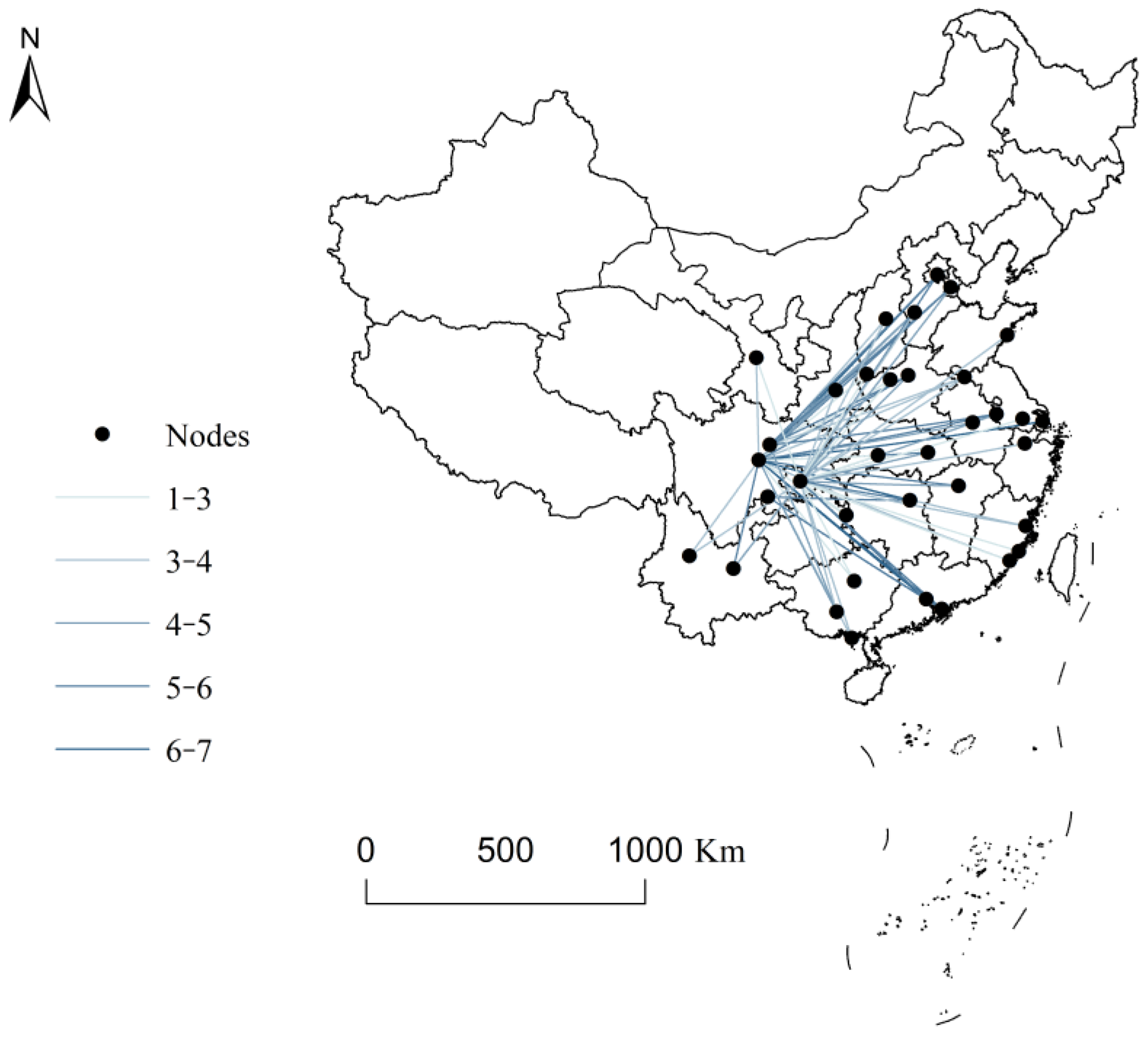
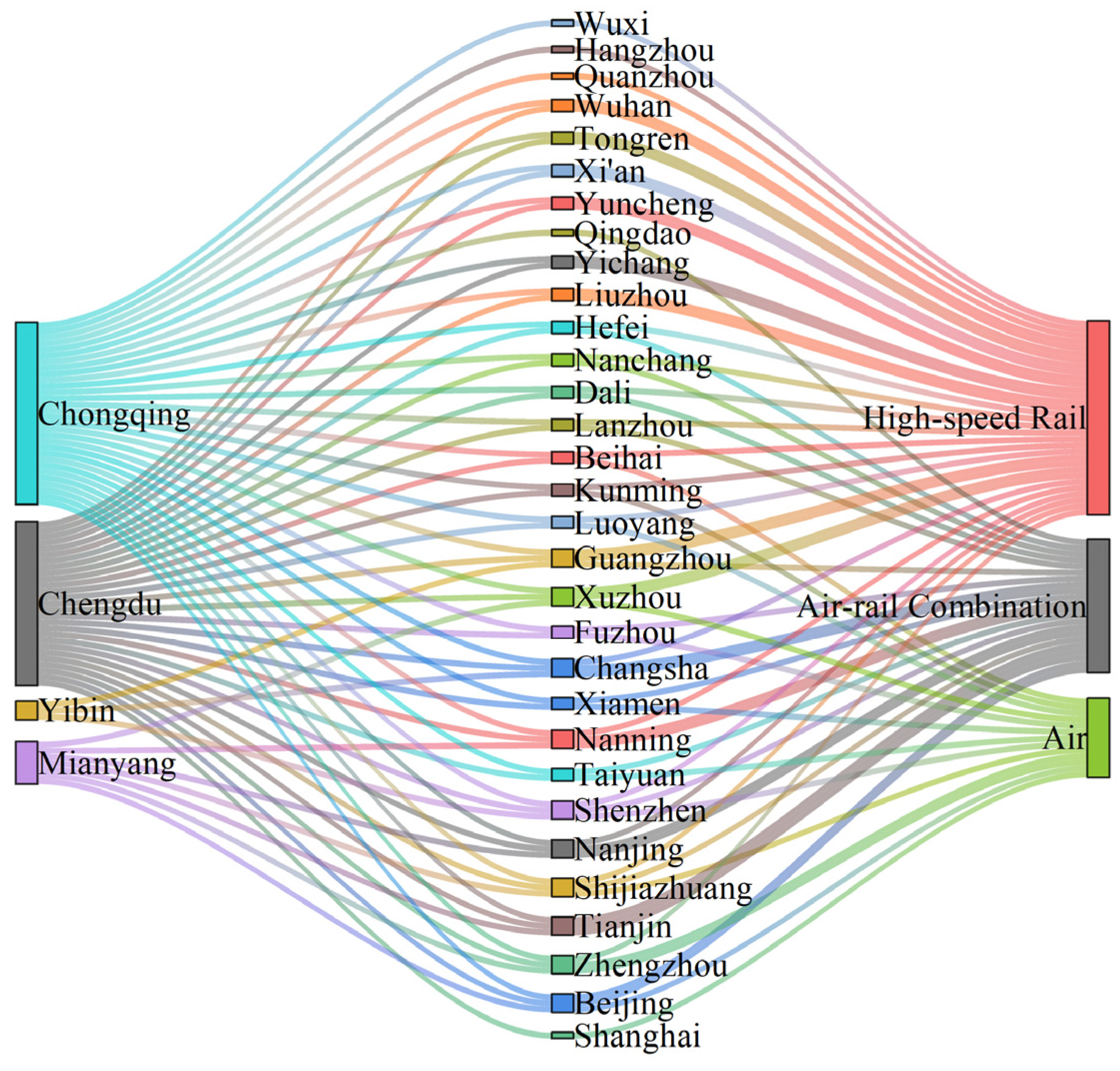
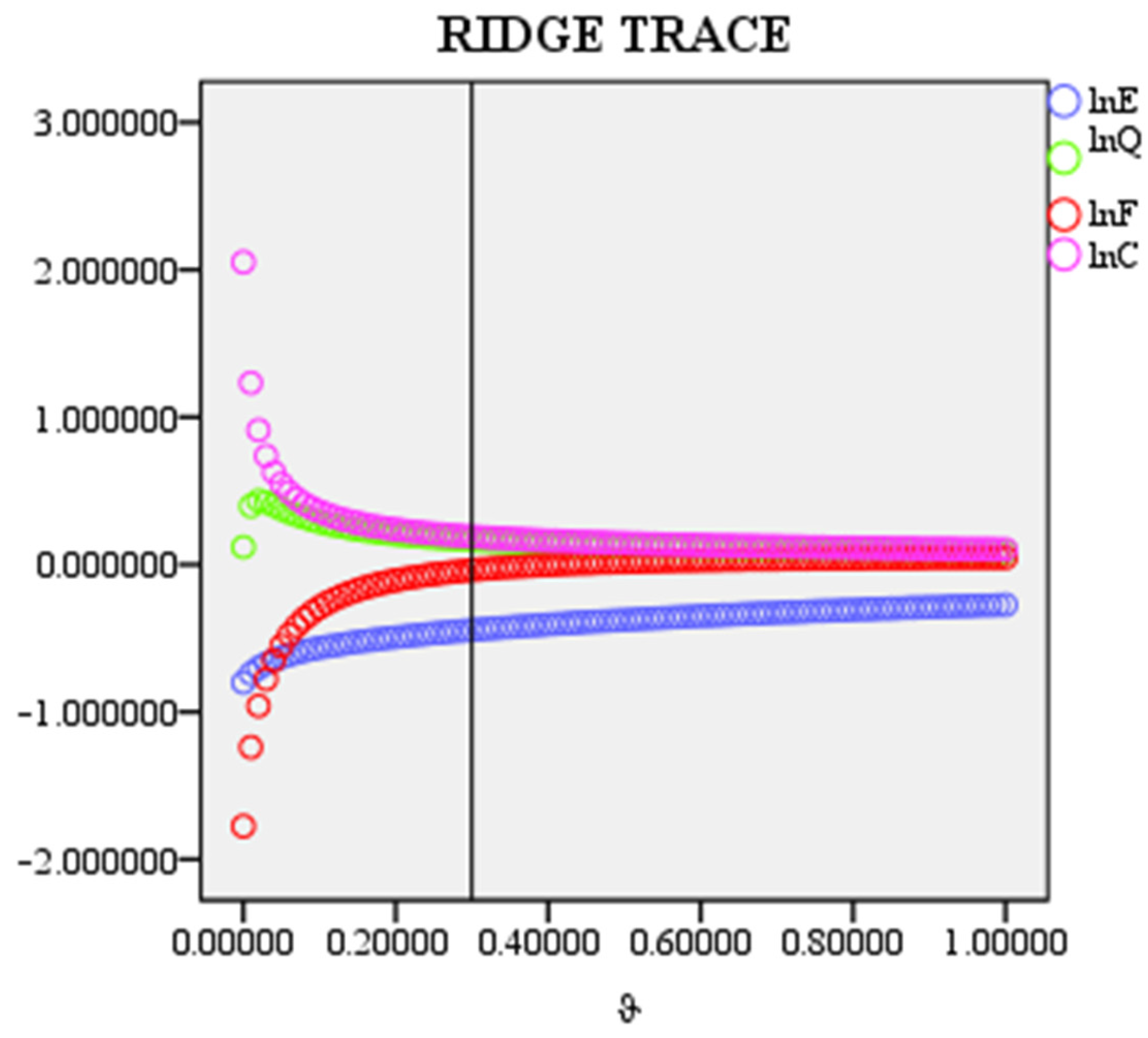
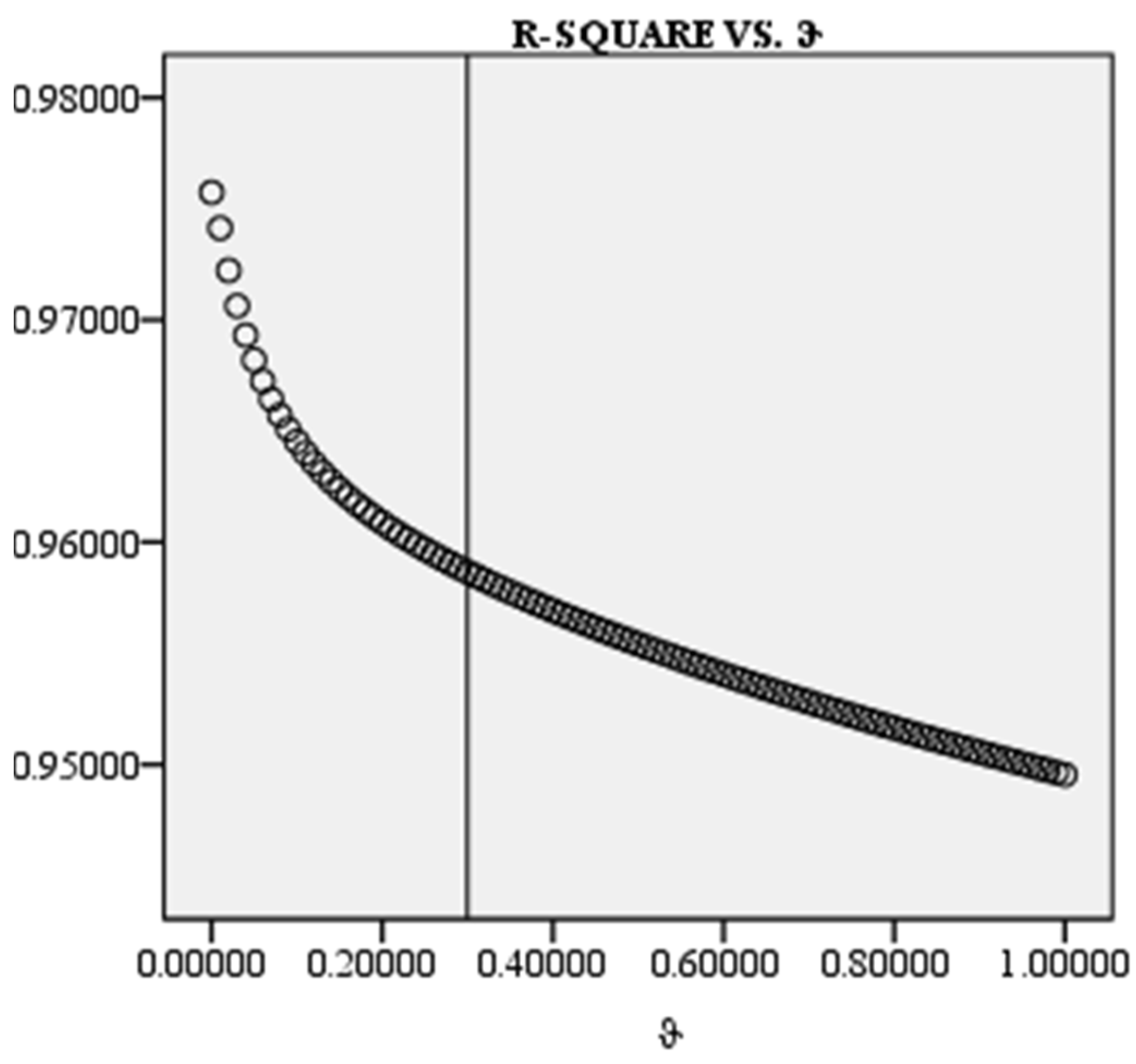
| Variable | A | H | HA |
|---|---|---|---|
| VIF | VIF | VIF | |
| lnE | 1.41 | 2.24 | 1.02 |
| lnQ | 33.42 | 70.38 | 70.74 |
| lnF | 20.77 | 7.75 | 5.87 |
| lnC | 54.89 | 44.11 | 54.35 |
| Mean VIF | 27.62 | 31.12 | 33.00 |
| Variable | Coefficient | Standard Error | Standard Coefficient | t-Statistic | Sig.t |
|---|---|---|---|---|---|
| lnE | −0.224 | 0.017 | −0.221 | −13.013 | 0.001 |
| lnQ | 0.235 | 0.015 | 0.231 | 15.631 | 0.001 |
| lnF | 0.239 | 0.015 | 0.235 | 15.680 | 0.001 |
| lnC | 0.243 | 0.016 | 0.240 | 15.067 | 0.001 |
| Constant | −0.370 | 1.507 | 0.000 | −0.245 | 0.001 |
| Variable | A | H | HA | |||
|---|---|---|---|---|---|---|
| Coefficient | Std. Error | Coefficient | Std. Error | Coefficient | Std. Error | |
| ln E | −0.224 *** | 0.017 | −0.230 *** | 0.016 | −0.312 *** | 0.047 |
| ln Q | 0.235 *** | 0.015 | 0.233 *** | 0.016 | 0.061 *** | 0.022 |
| ln F | 0.239 *** | 0.015 | 0.242 *** | 0.017 | −0.036 | 0.056 |
| ln C | 0.243 *** | 0.016 | 0.240 *** | 0.016 | 0.095 *** | 0.024 |
| Constant | −0.370 *** | 1.507 | −0.747 * | 1.585 | 0.433 | 0.407 |
| Modes | Fatigue Recovery Time | |||
|---|---|---|---|---|
| Parameter | Average | t | Elastic | |
| High-speed rail | −0.534 | 1.751 | −5.098 | 0.615 |
| Air | 0.249 | 0.356 | 2.074 | 0.061 |
| Air–rail | 0.365 | 0.549 | 3.159 | 0.134 |
| Modes | Travel Time | |||
|---|---|---|---|---|
| Parameter | Average | t | Elastic | |
| High-speed rail | −0.640 | 8.189 | −6.712 | 3.394 |
| Air | 0.252 | 2.045 | 2.100 | 0.356 |
| Air–rail | 0.407 | 3.714 | 3.595 | 1.008 |
| Modes | Per Capita Time Value | |||
|---|---|---|---|---|
| Parameter | Average | t | Elastic | |
| High-speed rail | −0.390 | 48.325 | −3.420 | 12.049 |
| Air | 0.252 | 48.325 | 2.100 | 8.402 |
| Air–rail | 0.261 | 48.325 | 2.180 | 8.460 |
Disclaimer/Publisher’s Note: The statements, opinions and data contained in all publications are solely those of the individual author(s) and contributor(s) and not of MDPI and/or the editor(s). MDPI and/or the editor(s) disclaim responsibility for any injury to people or property resulting from any ideas, methods, instructions or products referred to in the content. |
© 2022 by the authors. Licensee MDPI, Basel, Switzerland. This article is an open access article distributed under the terms and conditions of the Creative Commons Attribution (CC BY) license (https://creativecommons.org/licenses/by/4.0/).
Share and Cite
Zhang, P.; Ding, R.; Zhao, W.; Zhang, L.; Sun, H. Passenger Travel Path Selection Based on the Characteristic Value of Transport Services. Sustainability 2023, 15, 636. https://doi.org/10.3390/su15010636
Zhang P, Ding R, Zhao W, Zhang L, Sun H. Passenger Travel Path Selection Based on the Characteristic Value of Transport Services. Sustainability. 2023; 15(1):636. https://doi.org/10.3390/su15010636
Chicago/Turabian StyleZhang, Peiwen, Rui Ding, Wenke Zhao, Liaodong Zhang, and Hong Sun. 2023. "Passenger Travel Path Selection Based on the Characteristic Value of Transport Services" Sustainability 15, no. 1: 636. https://doi.org/10.3390/su15010636
APA StyleZhang, P., Ding, R., Zhao, W., Zhang, L., & Sun, H. (2023). Passenger Travel Path Selection Based on the Characteristic Value of Transport Services. Sustainability, 15(1), 636. https://doi.org/10.3390/su15010636








